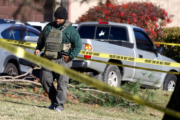WASHINGTON – Virginia plans to begin allowing commuter buses to use the shoulders of Interstate 66 inside the Capitol Beltway as part of a pilot project aimed at reducing congestion along the heavily traveled route.
At a task force hearing on buses on shoulder lanes, Virginia and Maryland transportation officials briefed members about how they could ease congestion along Interstate 270 and I-66. The task force is part of the Transportation Planning Board at the Metropolitan Washington Council of Governments.
Virginia Department of Transportation officials are considerably further along than Maryland. The agency hopes to begin its pilot program in 2014 along five segments of I-66 inside the Beltway.
Travelers are able to use the shoulders west of the Beltway during certain hours of the day.
“We were told to make sure something is up and running in 16 to 18 months”, says Kanti Srikanth, director of transportation planning at VDOT.
The pilot segments would run:
- Eastbound from the Dulles Toll Road to Haycock Road
- Eastbound from North Sycamore Street to North Jacksonville Street
- Westbound from North Quincy Drive to North George Mason Drive
- East and Westbound from North Spout Run Parkway to North Nash Street
“That means there are fewer people driving in cars and those that continue to drive will receive the benefit of less competition on the road,” says Arlington County Board Member Chris Zimmerman.
According to VDOT, the pilot program will cost about $2.1 million and would last 12 months.
“Our strategy on the planning level is find the money from existing projects,” says Srikanth, who was confident the money would be there.
Meanwhile in Maryland, a similar project to allow buses to use the shoulder lane along I-270 between Interstate 70 and the Beltway is still several years away.
“The most important point is that this is a preliminary effort. We’re just entering the game here,” says Barrett Kiedrowski with the Maryland State Highway Authority.
“We just started this year ago. I am very pleased on where we’ve come,” says City of Frederick Alderman Carol Krimm, who arrived at the meeting late because of traffic on I-270.
“The Maryland Department of Transportation is now considering the option on I-270, which is congested. But I would encourage the local counties to put this project in their Priority Letters,” says Krimm, referring to the annual letter that counties send to the Department of Transportation to seek funding for a list of top local projects.
Officials hope a new state transportation funding package may help the effort along.
But during the state highway administration presentation, planners admitted several problems that have yet to be addressed. Among them are traffic choke points in Montgomery and Frederick counties and conflict points where buses would cross other traffic, like at an exit ramp.
In total, there would be 22 choke or conflict points, along with 17 spots along bridges where the shoulder would need to be lengthened or widened to allow buses to use them.
The highway administration does not have the money to study such problems, nor does it have the $3 million to $6 million the agency says it would cost per mile to improve the shoulder for bus travel.
The Monocacy Battlefield, a historic landmark in Frederick along I-270, poses another problem.
The presentation left one transit watcher dismayed at the lack of progress in Maryland, compared to those across the Potomac.
“You’re going to see the difference between something that’s very close to implementation and Maryland that’s just starting to look at the concept,” says Krimm.
“It took Virginia passing a transportation package before Maryland woke up and got something done. Maybe, once again, it’ll take Virginia taking the lead on the bus on the shoulder pilot to get us in gear about doing it on 270,” says Tina Slater, president of the Montgomery County Action Committee for Transit.
The task force plans to issue recommendations to the Transportation Planning Board early this summer.
Follow @AriAsheWTOP and @WTOP on Twitter.







